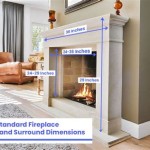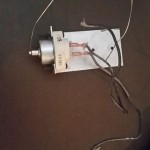Gas Fireplace Doors: Open or Closed? A Comprehensive Guide
The question of whether to operate a gas fireplace with the doors open or closed is a common one, often sparking debate and confusion among homeowners. The appropriate method depends heavily on the specific fireplace model, its design, and the manufacturer's instructions. Deviating from these guidelines can lead to inefficiencies, potential safety hazards, and even damage to the fireplace unit or the surrounding environment.
The primary function of a gas fireplace is to provide supplemental heating and aesthetic appeal. Modern gas fireplaces come in various designs, including direct vent, vent-free, and B-vent models. Each type operates differently and thus has specific requirements regarding door operation. Understanding these differences is crucial before making a decision about leaving the doors open or closed.
A significant factor influencing the decision is the type of glass used in the fireplace. Some models feature tempered glass, while others utilize ceramic glass. Tempered glass is typically less resistant to high temperatures compared to ceramic glass. Operating a fireplace with tempered glass doors closed for extended periods can potentially lead to cracking or shattering due to excessive heat buildup. Ceramic glass, on the other hand, is designed to withstand significantly higher temperatures, making it more suitable for closed-door operation.
It is imperative to consult the owner’s manual for the specific gas fireplace model. The manufacturer provides detailed instructions regarding proper operation, including whether the doors should be open or closed during use. Disregarding these instructions can void the warranty and potentially create unsafe operating conditions. The manual will typically specify the type of glass used and provide guidance on safe and efficient operation.
Understanding Fireplace Types and Door Operation
Gas fireplaces are broadly classified into several types, each with distinct venting systems and operational characteristics. These differences directly impact the suitability of open or closed-door operation.
Direct Vent Fireplaces: These fireplaces draw combustion air from outside the home and vent exhaust gases directly outdoors through a sealed system. Direct vent fireplaces are typically more efficient and safer than other types because they do not rely on indoor air for combustion. The doors on direct vent models are generally designed to remain closed during operation. This closed-door operation helps maintain the efficiency of the unit and prevents the escape of exhaust gases into the living space. The sealed combustion system ensures that all byproducts of combustion are safely vented outside.
Vent-Free Fireplaces: Also known as ventless fireplaces, these models do not require a chimney or vent. They burn gas very cleanly, producing minimal exhaust gases. Vent-free fireplaces rely on a built-in oxygen depletion sensor (ODS) to shut off the gas supply if oxygen levels in the room become too low. While convenient and relatively easy to install, vent-free fireplaces require careful consideration regarding door operation. In most cases, the doors on vent-free fireplaces are designed to remain open during operation. This allows for adequate ventilation and prevents the buildup of heat within the firebox. Operating a vent-free fireplace with the doors closed can lead to overheating, potential damage to the unit, and an increased risk of carbon monoxide buildup. Some vent-free units, however, are specifically designed and certified for closed-door operation. These models will have explicit instructions in the owner’s manual.
B-Vent Fireplaces: B-vent fireplaces utilize a natural draft chimney to vent exhaust gases. They draw combustion air from the room and vent the exhaust through a vertical vent. B-vent fireplaces are less efficient than direct vent models and require a functional chimney system. The door operation for B-vent fireplaces can vary depending on the specific model. Some B-vent fireplaces are designed to be operated with the doors open, while others are designed for closed-door operation. Again, the manufacturer's instructions are the definitive guide. Operating a B-vent fireplace with the doors closed when it is designed for open-door operation can lead to incomplete combustion and the release of harmful gases into the living space.
It is essential to identify the type of gas fireplace installed in the home and carefully review the corresponding owner's manual to determine the correct door operation procedure. Misunderstanding the fireplace type can lead to unsafe operating conditions and potential damage to the unit.
Safety Considerations: Carbon Monoxide and Overheating
The safe operation of a gas fireplace is paramount, and the position of the doors—open or closed—plays a significant role in ensuring safety. Two major concerns are carbon monoxide poisoning and overheating.
Carbon Monoxide: Carbon monoxide (CO) is a colorless, odorless, and tasteless gas produced by the incomplete combustion of fuels, including natural gas and propane. Exposure to high levels of CO can be fatal. A properly functioning gas fireplace should burn gas cleanly, producing minimal CO. However, malfunctions, improper ventilation, or incorrect door operation can lead to CO buildup. Operating a fireplace with the doors closed when it is designed for open-door operation can restrict airflow and lead to incomplete combustion, increasing the risk of CO poisoning. Furthermore, a blocked or damaged vent can also cause CO to accumulate indoors. Carbon monoxide detectors should be installed in the home to provide an early warning of CO buildup. Regular inspection and maintenance of the gas fireplace are also crucial to ensure safe operation.
Overheating: Operating a gas fireplace with the doors closed when it is designed for open-door operation can lead to excessive heat buildup within the firebox. This overheating can damage the fireplace components, including the glass, burner, and control valves. In extreme cases, overheating can also pose a fire hazard. Tempered glass, in particular, is susceptible to cracking or shattering under high temperatures. Ceramic glass is more resistant to heat but can still be damaged by prolonged exposure to excessive temperatures. The heat can also damage the surrounding structure, like the mantel or wall. Proper ventilation, as specified by the manufacturer, is essential to prevent overheating.
Regularly inspect the gas fireplace for any signs of damage or malfunction. If any problems are detected, such as unusual odors, flickering flames, or sooting, the fireplace should be turned off immediately, and a qualified technician should be contacted for inspection and repair. Maintain clear area around the fireplace to prevent flammable materials from igniting.
Efficiency and Heat Output: Optimizing Performance
The efficiency and heat output of a gas fireplace are influenced by several factors, including the type of fireplace, its design, and the door operation. Optimizing these factors can help maximize the heating benefits and minimize energy consumption.
Closed-Door Operation and Efficiency: Direct vent fireplaces are typically designed for closed-door operation. This design helps to maintain the efficiency of the unit by preventing the escape of heat into the room. The sealed combustion system ensures that all combustion air is drawn from outside, and exhaust gases are vented directly outdoors. This closed-loop system minimizes heat loss and maximizes the amount of heat transferred to the living space. Operating a direct vent fireplace with the doors open can reduce its efficiency and increase energy consumption.
Open-Door Operation and Heat Distribution: Vent-free fireplaces, which are typically designed for open-door operation, rely on radiant heat to warm the room. The open doors allow the heat to radiate directly into the living space. However, this type of heat distribution can be uneven, with areas closer to the fireplace receiving more heat than those farther away. Vent-free fireplaces are generally less efficient than direct vent models because they lose some heat through the open doors.
Adjusting Flame Height: Many gas fireplaces have adjustable flame height settings. Lowering the flame height can reduce the heat output and energy consumption. However, it is important to ensure that the flame is still burning cleanly and efficiently. A low flame setting can sometimes lead to incomplete combustion, increasing the risk of CO buildup. Always follow the manufacturer's instructions for adjusting the flame height. Some fireplaces are designed with variable control that automatically adjusts air mixture for maximizing efficiency.
Maintaining the Fireplace: Regular maintenance is essential for optimizing the efficiency and heat output of a gas fireplace. This includes cleaning the glass, inspecting the burner, and ensuring that the vent is clear of any obstructions. A dirty or obstructed vent can reduce airflow and lead to incomplete combustion, reducing efficiency and increasing the risk of CO poisoning. A qualified technician should inspect the gas fireplace annually to ensure that it is operating safely and efficiently.
Ultimately, the decision of whether to operate a gas fireplace with the doors open or closed hinges on understanding the fireplace type, adhering to the manufacturer's instructions, and prioritizing safety. Regular maintenance and proper operation are key to enjoying the comfort and ambiance of a gas fireplace while minimizing risks and maximizing efficiency.

Should Your Fireplace Doors Be Open Or Closed While Burning

Fireplace Doors Should I Keep Them Opened Or Closed Why Its Necessary

Should Your Fireplace Doors Be Open Or Closed While Burning

Fireplace Glass Doors Open Or Closed The Definitive Answer
Fireplace Doors Mechanical Problems Chimneys Com

Fireplace Glass Doors Open Or Closed The Definitive Answer

5 Big Reasons You Need Fireplace Doors Helpful Advice

Fireplace Doors Should I Keep Them Opened Or Closed Why Its Necessary

Why You Need Glass Doors On Your Fireplace

Glass Fireplace Doors








